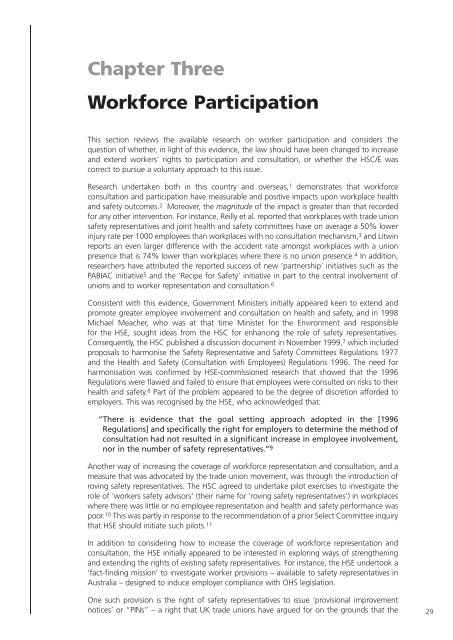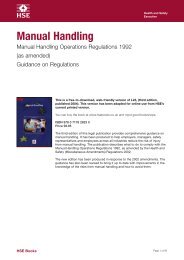Making Companies Safe - what works? (CCA ... - Unite the Union
Making Companies Safe - what works? (CCA ... - Unite the Union
Making Companies Safe - what works? (CCA ... - Unite the Union
Create successful ePaper yourself
Turn your PDF publications into a flip-book with our unique Google optimized e-Paper software.
Chapter Three<br />
Workforce Participation<br />
This section reviews <strong>the</strong> available research on worker participation and considers <strong>the</strong><br />
question of whe<strong>the</strong>r, in light of this evidence, <strong>the</strong> law should have been changed to increase<br />
and extend workers’ rights to participation and consultation, or whe<strong>the</strong>r <strong>the</strong> HSC/E was<br />
correct to pursue a voluntary approach to this issue.<br />
Research undertaken both in this country and overseas, 1 demonstrates that workforce<br />
consultation and participation have measurable and positive impacts upon workplace health<br />
and safety outcomes. 2 Moreover, <strong>the</strong> magnitude of <strong>the</strong> impact is greater than that recorded<br />
for any o<strong>the</strong>r intervention. For instance, Reilly et al. reported that workplaces with trade union<br />
safety representatives and joint health and safety committees have on average a 50% lower<br />
injury rate per 1000 employees than workplaces with no consultation mechanism, 3 and Litwin<br />
reports an even larger difference with <strong>the</strong> accident rate amongst workplaces with a union<br />
presence that is 74% lower than workplaces where <strong>the</strong>re is no union presence. 4 In addition,<br />
researchers have attributed <strong>the</strong> reported success of new ‘partnership’ initiatives such as <strong>the</strong><br />
PABIAC initiative 5 and <strong>the</strong> ‘Recipe for <strong>Safe</strong>ty’ initiative in part to <strong>the</strong> central involvement of<br />
unions and to worker representation and consultation. 6<br />
Consistent with this evidence, Government Ministers initially appeared keen to extend and<br />
promote greater employee involvement and consultation on health and safety, and in 1998<br />
Michael Meacher, who was at that time Minister for <strong>the</strong> Environment and responsible<br />
for <strong>the</strong> HSE, sought ideas from <strong>the</strong> HSC for enhancing <strong>the</strong> role of safety representatives.<br />
Consequently, <strong>the</strong> HSC published a discussion document in November 1999, 7 which included<br />
proposals to harmonise <strong>the</strong> <strong>Safe</strong>ty Representative and <strong>Safe</strong>ty Committees Regulations 1977<br />
and <strong>the</strong> Health and <strong>Safe</strong>ty (Consultation with Employees) Regulations 1996. The need for<br />
harmonisation was confirmed by HSE-commissioned research that showed that <strong>the</strong> 1996<br />
Regulations were flawed and failed to ensure that employees were consulted on risks to <strong>the</strong>ir<br />
health and safety. 8 Part of <strong>the</strong> problem appeared to be <strong>the</strong> degree of discretion afforded to<br />
employers. This was recognised by <strong>the</strong> HSE, who acknowledged that:<br />
“There is evidence that <strong>the</strong> goal setting approach adopted in <strong>the</strong> [1996<br />
Regulations] and specifically <strong>the</strong> right for employers to determine <strong>the</strong> method of<br />
consultation had not resulted in a significant increase in employee involvement,<br />
nor in <strong>the</strong> number of safety representatives.” 9<br />
Ano<strong>the</strong>r way of increasing <strong>the</strong> coverage of workforce representation and consultation, and a<br />
measure that was advocated by <strong>the</strong> trade union movement, was through <strong>the</strong> introduction of<br />
roving safety representatives. The HSC agreed to undertake pilot exercises to investigate <strong>the</strong><br />
role of ‘workers safety advisors’ (<strong>the</strong>ir name for ‘roving safety representatives’) in workplaces<br />
where <strong>the</strong>re was little or no employee representation and health and safety performance was<br />
poor. 10 This was partly in response to <strong>the</strong> recommendation of a prior Select Committee inquiry<br />
that HSE should initiate such pilots. 11<br />
In addition to considering how to increase <strong>the</strong> coverage of workforce representation and<br />
consultation, <strong>the</strong> HSE initially appeared to be interested in exploring ways of streng<strong>the</strong>ning<br />
and extending <strong>the</strong> rights of existing safety representatives. For instance, <strong>the</strong> HSE undertook a<br />
‘fact-finding mission’ to investigate worker provisions – available to safety representatives in<br />
Australia – designed to induce employer compliance with OHS legislation.<br />
One such provision is <strong>the</strong> right of safety representatives to issue ‘provisional improvement<br />
notices’ or “PINs” – a right that UK trade unions have argued for on <strong>the</strong> grounds that <strong>the</strong> 29
















